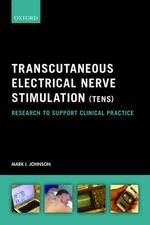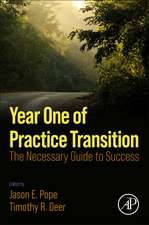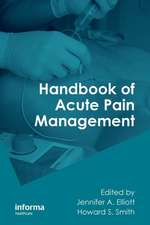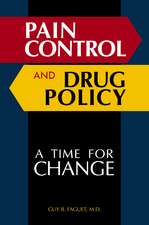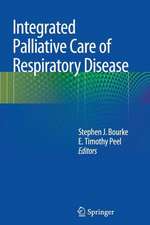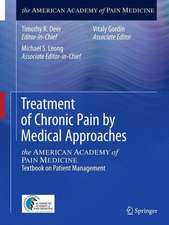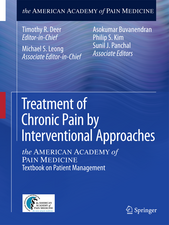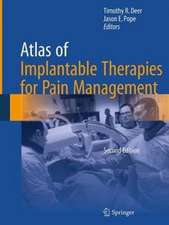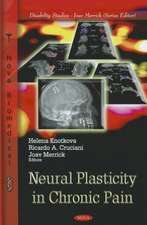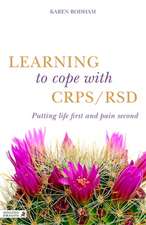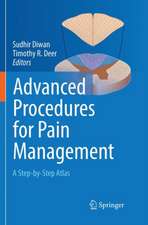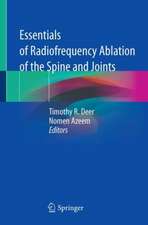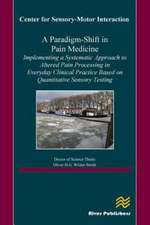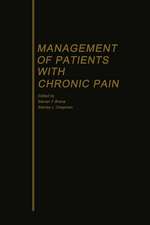Comprehensive Treatment of Chronic Pain by Medical, Interventional, and Integrative Approaches: The AMERICAN ACADEMY OF PAIN MEDICINE Textbook on Patient Management
Editat de Timothy R. Deer, Michael S Leong, Asokumar Buvanendran, Vitaly Gordin, Philip S. Kim, Sunil J. Panchal, Albert L. Rayen Limba Engleză Hardback – 15 mar 2013
· Written and edited by world-class authorities
· “Key Points” preview contents of each chapter
· Leading edge medical topics, such as monitoring opioid use and abuse, and the emerging role of cannabinoids in pain treatment
· Expert guidance on full range of interventional techniques
· Clinical anatomy and physiology for the interventionist
· Behavioral dimensions of the experience and management of pain
· Integrative approaches for treating the “whole person”
· Legal issues, such as failure to treat pain
· First-hand patient accounts
Preț: 1710.12 lei
Preț vechi: 1800.13 lei
-5% Nou
Puncte Express: 2565
Preț estimativ în valută:
327.22€ • 341.65$ • 270.82£
327.22€ • 341.65$ • 270.82£
Carte disponibilă
Livrare economică 15-29 martie
Preluare comenzi: 021 569.72.76
Specificații
ISBN-13: 9781461415596
ISBN-10: 1461415594
Pagini: 1104
Ilustrații: XXVII, 1104 p. 412 illus., 233 illus. in color.
Dimensiuni: 210 x 279 x 69 mm
Greutate: 3.18 kg
Ediția:2013
Editura: Springer
Colecția Springer
Locul publicării:New York, NY, United States
ISBN-10: 1461415594
Pagini: 1104
Ilustrații: XXVII, 1104 p. 412 illus., 233 illus. in color.
Dimensiuni: 210 x 279 x 69 mm
Greutate: 3.18 kg
Ediția:2013
Editura: Springer
Colecția Springer
Locul publicării:New York, NY, United States
Public țintă
Professional/practitionerCuprins
Part I. Medical Approaches.- 1. A Survey of Systems Involved in Nociceptive Processing.- 2. Pharmacogenomics of Pain Management.- 3. Nonsteroidal Anti-inflammatory Drugs.- 4. The Role of Antidepressants in the Treatment of Chronic Pain.- 5. Anticonvulsant Medications for Treatment of Neuropathic and “Functional” Pain.- 6. NMDA Receptor Antagonists in the Treatment of Pain.- 7. Role of Muscle Relaxants in the Treatment of Pain.- 8. Topical Analgesics.- 9. Sleep Aids.- 10. Clinical Use of Opioids.- 11. Opioid Adverse Effects and Opioid-Induced Hypogonadism.- 12. Acute Management of the Opioid-Dependent Patient.- 13. Opioids and the Law.- 14. Methadone for Chronic Pain.- 15. Toxicology Screening for Opioids.- 16. Monitoring Drug Use and Abuse: The Evolution of a Paradigm.- 17. Polypharmacy and Drug Interaction.- 18. Role of Cannabinoids in Pain Management.- 19. The Future of Pain Pharmacotherapy.- Part II. Interventional Approaches: Anatomy and Physiology of Pain.- 20. Neuroanatomy and Neurophysiology of Pain.- 21. Spinal Targets for Interventional Pain Management.- 22. Functional Anatomy and Imaging of the Spine.- Part III. Interventional Approaches: Neural Blockade and Neurolysis Blocks.- 23. Local Anesthetics.- 24. Neurolytic Agents.- 25. Cryoanalgesia.- 26. Radiofrequency: Conventional and Pulsed.- 27. Atlanto-Axial and Atlanto-Occipital Joints Injection in the Treatment of Headaches and Neck Pain.- 28. Sphenopalatine Ganglion Block.- 29. Occipital Nerve Block.- 30. Neural Blockade for Trigeminal Neuralgia.- 31. Glossopharyngeal Nerve Block.- 32. Cervical Plexus Block.- 33. Stellate Ganglion Blockade.- 34. Epidural (Cervical, Thoracic, Lumbar, Caudal) Block/Injections.- 35. Transforaminal Epidural Steroid Injections.- 36. Facet Injections and Radiofrequency Denervation.- 37. Intercostal Nerve Blocks.- 38. Intrapleural Catheters.- 39. Epidural Lysis of Adhesions: Percutaneous and Endoscopic Techniques.- 40. Thoracic and Lumbar Sympathetic Nerve Block andNeurolysis.- 41. Celiac Plexus, Splanchnic Nerve Block, and Neurolysis.- 42. Superior Hypogastric Plexus, Ganglion Impar Blocks, and Neurolysis.- 43. Peripheral Neurolysis.- 44. Central Neuraxial Neurolysis.- 45. Provocative Discography.- 46. Brachial Plexus Block.- 47. Suprascapular Nerve Block.- 48. Intradiscal Annuloplasty for the Treatment of Discogenic Pain.- 49. Percutaneous Disc Decompression.- 50. The Racz Procedure: Lysis of Epidural Adhesions (Percutaneous Neuroplasty).- 51. Sacroiliac Joint Injection and Radiofrequency Denervation.- 52. Vertebral Augmentation: Vertebroplasty and Kyphoplasty.- 53. Piriformis Injection.- 54. Botulinum Toxin in the Management of Painful Conditions.- 55. Emerging Imaging Tools for Interventional Pain.- Part IV. Interventional Approaches: Neuromodulation.- 56. A History of Neurostimulation.- 57. Stimulation of the Peripheral Nerve and Peripheral Nerve Field.- 58. Spinal Cord Stimulation.- 59. Brain Stimulation for Pain.- 60. Motor Cortex Stimulation.- 61. Intrathecal Drug Delivery for Control of Pain.- 62. Clinical Applications of Neuromodulation: Radicular Pain and Low Back Pain.- 63. Clinical Applications of Neuromodulation: Neurostimulation for Complex Regional Pain Syndrome.- 64. Clinical Applications of Neuromodulation: Section on Angina and Peripheral Vascular Disease.- 65. Clinical Applications of Neuromodulation: Spinal Cord Stimulation for Abdominal Pain.- 66. Cost-Effectiveness of Interventional Techniques.- 67. Neurosurgical Techniques for Pain Management.- 68. Spinal Cord Stimulation in the Treatment of Postherpetic Neuralgia.- 69. Complications of Interventional Pain Management Techniques.- Part V. Integrative Approaches.- 70. Pain as a Perceptual Experience.- 71. Neuroplasticity, Sensitization, and Pain.- 72. Muscle Pain Treatment.- 73. Addictive Disorders and Pain.- 74. The “Five-Minute” Mental Status Examination of Persons with Pain.- 75. The Psychological Assessment of Patients with Chronic Pain.- 76.Psychological Therapies.- 77. Billing Psychological Services for Patients with Chronic Pain.- 78. Hypnosis and Pain Control.- 79. Acupuncture.- 80. Manual Therapies.- 81. Treatment of Chronic Painful Musculoskeletal Injuries and Diseases with Regenerative Injection Therapy (RIT): Regenerative Injection Therapy Principles and Practice.- 82. Interdisciplinary Functional Restoration and Pain Programs.- 83. Pain and Spirituality.- 84. Pain Disparity: Assessment and Traditional Medicine.- 85. Sleep and Chronic Pain.- 86. Empowerment: A Pain Caregiver’s Perspective.- 87. Patient and Caregiver’s Perspective.- 88. Pain Medicine in Older Adults: How Should It Differ?.- 89. Pain Medicine and Primary Care: The Evolution of a Population-Based Approach to Chronic Pain as a Public Health Problem.- 90. Pain Care Beyond the Medical Practice Office: Utilizing Patient Advocacy, Education, and Support Organizations.- 91. Neonatal Pain.- 92. Assessing Disability in the Pain Patient.- 93. The Double Effect: In Theory and in Practice.- 94. Failure to Treat Pain.
Recenzii
“Comprehensive Treatment of Chronic Pain is a major textbook … . The contributors come from all over the United States, with even some input from Canada, and from a wide variety of specialties. … There are many colored illustrations that greatly add to the understanding, especially of block techniques. … it should be a part of all departmental libraries and in the reference collection of pain fellows and pain practitioners.” (Elizabeth A. M. Frost, Journal of Neurosurgical Anesthesiology, August, 2013)
“This book on the clinical aspects of chronic pain management covers both interventional and noninterventional therapies. … Although the primary audience is chronic pain physicians and primary care givers, anyone managing patients with chronic pain conditions in their practice will find the book very useful. … The information is extremely practical and clinically useful. Chapters on procedures are usually well described … . Both the content and the short discussions in each chapter make it a good pain reference for a busy practice.” (Tariq M. Malik, Doody’s Book Reviews, June, 2013)
“This book on the clinical aspects of chronic pain management covers both interventional and noninterventional therapies. … Although the primary audience is chronic pain physicians and primary care givers, anyone managing patients with chronic pain conditions in their practice will find the book very useful. … The information is extremely practical and clinically useful. Chapters on procedures are usually well described … . Both the content and the short discussions in each chapter make it a good pain reference for a busy practice.” (Tariq M. Malik, Doody’s Book Reviews, June, 2013)
Notă biografică
Timothy S. Deer, MD
President and CEO
The Center for Pain Relief
Clinical Professor of Anesthesiology
West Virginia University School of Medicine
Charleston, WV USA
Michael S. Leong, MD
Clinic Chief
Stanford Pain Management Center
Redwood City, CA
Clinical Assistant Professor
Department of Anesthesiology
Stanford University School of Medicine
Stanford, CA USA
Asokumar Buvanendran, MD
Professor
Department of Anesthesiology
Rush Medical College
Director
Orthopedic Anesthesia
Rush University Medical Center
Chicago, IL USA
Vitaly Gordin, MD
Associate Professor
Associate Vice Chair of Pain Management
Department of Anesthesiology
Pennsylvania State University College of Medicine
Director, Pain Medicine
Milton S. Hershey Medical Center
Hershey, PA USA
Philip S. Kim, MD
Medical Director
Center for Interventional Pain and Spine
Newark, DE USA
Center for Pain Management
Bryn Mawr Hospital
Bryn Mawr, PA USA
Sunil J. Panchal, MD
President
National Institute of Pain
Tampa, FL USA
Albert L. Ray, MD
Medical Director
The LITE Center
Clinical Associate Professor
University of Miami Miller School of Medicine
Miami, FL USA
President and CEO
The Center for Pain Relief
Clinical Professor of Anesthesiology
West Virginia University School of Medicine
Charleston, WV USA
Michael S. Leong, MD
Clinic Chief
Stanford Pain Management Center
Redwood City, CA
Clinical Assistant Professor
Department of Anesthesiology
Stanford University School of Medicine
Stanford, CA USA
Asokumar Buvanendran, MD
Professor
Department of Anesthesiology
Rush Medical College
Director
Orthopedic Anesthesia
Rush University Medical Center
Chicago, IL USA
Vitaly Gordin, MD
Associate Professor
Associate Vice Chair of Pain Management
Department of Anesthesiology
Pennsylvania State University College of Medicine
Director, Pain Medicine
Milton S. Hershey Medical Center
Hershey, PA USA
Philip S. Kim, MD
Medical Director
Center for Interventional Pain and Spine
Newark, DE USA
Center for Pain Management
Bryn Mawr Hospital
Bryn Mawr, PA USA
Sunil J. Panchal, MD
President
National Institute of Pain
Tampa, FL USA
Albert L. Ray, MD
Medical Director
The LITE Center
Clinical Associate Professor
University of Miami Miller School of Medicine
Miami, FL USA
Textul de pe ultima copertă
Edited by master clinician-experts appointed by the American Academy of Pain Medicine, this is a state-of-the-art multidisciplinary textbook covering medical, interventional, and integrative approaches to the treatment and management of pain. It is designed as a practical and comprehensive primary reference for busy physicians and is also an up-to-date resource for preparing for certification examinations in pain medicine.
· Written and edited by world-class authorities
· “Key Points” preview contents of each chapter
· Leading edge medical topics, such as monitoring opioid use and abuse, and the emerging role of cannabinoids in pain treatment
· Expert guidance on full range of interventional techniques
· Clinical anatomy and physiology for the interventionist
· Behavioral dimensions of the experience and management of pain
· Integrative approaches for treating the “whole person”
· Legal issues, such as failure to treat pain
· First-hand patientaccounts
· Written and edited by world-class authorities
· “Key Points” preview contents of each chapter
· Leading edge medical topics, such as monitoring opioid use and abuse, and the emerging role of cannabinoids in pain treatment
· Expert guidance on full range of interventional techniques
· Clinical anatomy and physiology for the interventionist
· Behavioral dimensions of the experience and management of pain
· Integrative approaches for treating the “whole person”
· Legal issues, such as failure to treat pain
· First-hand patientaccounts
Caracteristici
Comprehensive treatment of all aspects of pain medicine Written and edited by highly esteemed members of the American Academy of Pain Medicine Numerous interventional procedures highlighted with full color, high quality illustrations Includes supplementary material: sn.pub/extras

